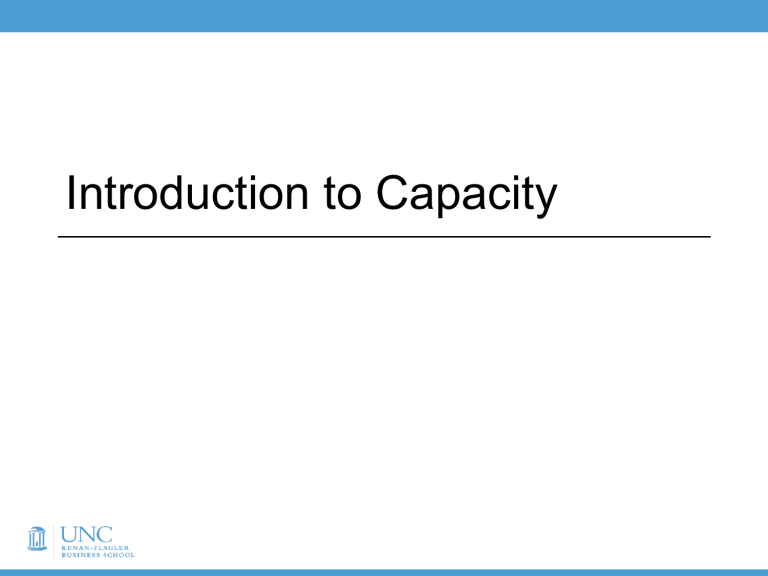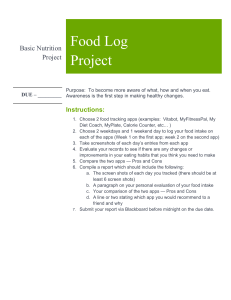
Introduction to Capacity Capacity: Basic Definition • Capacity: the productive capability of a facility, usually measured as a quantity of output per unit time • Why is capacity important? • To meet demand in the short term • Strategically • Better service (surge capacity) • Demand in the long term (timing) What Is a Bottleneck? The step in the production/service delivery process that: Bottleneck definition a) Has the lowest capacity when measured using a comparable unit of measure b) And, therefore, limits the overall output of the system How do you find a bottleneck? a) On paper: determine the capacity—using a comparable measure—of each step in the process b) Line of sight: find the place in the production process that has the highest level of work-inprocess (WIP) inventory Process Flow Diagrams Process Flow Diagram • Provides overview of process, including key steps and flow of customers/jobs through the process • Depicts bird’s-eye view of activity • Facilitates communication of process details throughout organization • Helpful in determining process capacity Four Key Elements of Process Flow Diagram Boxes Triangles Diamonds Arrows Boxes represent key steps in the process, where work (value added) is performed. Triangles represent buffers, where customers/jobs wait before processing. Diamonds represent decisions or branching points in the process. Arrows represent flow of customers/jobs through the processing network. Process Flow Diagram: Benihana Arriving Customers Bar Dining area Departing Customers Process Flow Diagram: Integrated Steel Mill Iron ore Blast furnace Iron ingots Coke Scrap steel Basic oxygen furnace Continuous caster Rolling mill Cold rolled coils Application Life Insurance Company Life Insurance Process Simplified example of a European life-insurance operation Broker’s office (Germany) Processing facility (Ireland) Administration department Information chasing team Customer (in Germany) fills out application with broker Obtain missing information N Broker e-mails application (app) to Dublin processing facility App complete? App review team Y Data entry Rate the policy Print and mail policy Data entry team Underwriting department Distribution team Processing Facility in Ireland • Review team (two people) • • Information chasing team (three people) • • All complete applications (both those originally complete and those completed by information chasing) are sent to data entry. A data entry person can key in an application in 12 minutes. Underwriting (UW) department (seven people) • • Incomplete apps are sent to the “information chasing” department. This department contacts the applicant to get the missing information. A person spends 30 minutes getting the missing information on an incomplete app. Data entry team (five people) • • Applications (apps) are reviewed for completeness. One person can review an app in four minutes. On average, 25% of arriving apps are incomplete. After data entry, the app is rated by the UW department. 83.333% of the apps are simple cases, and 16.666% are complex cases. One underwriter can rate a simple case in 20 minutes or a complex case in 40 minutes. Distribution team (two people) • After an app has been rated, it is sent to the distribution team, where the policy is printed and placed in an envelope. It takes one person five minutes to do this. Answering Question 1 Life Insurance Calculations Common unit of measure: applications/hour Review Information chasing Data entry Underwriting Distribution Life Insurance Summary Step Review Capacity (applications/hour) 1 app/4 min * 60 min/hr * 2P = 30 apps/hr Information chase 1 inc. app/20 min * 60 min/hr * 3p * 4 app/1 inc. app = 24 apps/hr Data entry 1 app/12 min * 60 min/hr * 5p = 25 apps/hr Underwriting Distribution 1 app/23.33 min * 60 min/hr * 7p = 18 apps/hr 1 app/5 min * 60 min/hr * 2p = 24 apps/hr Capacity of processing facility = Opportunity for Practice • The company is considering a new web-based software product. The software has the following benefits: • Brokers can submit an online app, rather than filling out a paper app. • Online apps are 100% complete (auto checks for unanswered questions). • There is no need for the processing facility to enter data for online apps. • Software comes with an expert underwriting system that can automatically rate simple cases. The expert system can be used on both online and paper applications. The processing facility will rate all simple cases using the expert system and all complex cases using human underwriters. The expert system effectively has an infinite capacity, so the underwriting department only has to rate the complex cases. • If the company forecasts that 40% of the apps would be submitted online, what would the capacity be? • Assume that 25% of the paper apps still arrive incomplete and that 16.666% of all apps (paper or online) are complex cases. Answering Question 2 Life Insurance Summary Step Review Capacity (applications/hour) 1 app/4 min * 60 min/hr * 2P = 30 apps/hr Information chase 1 inc. app/20 min * 60 min/hr * 3p * 4 app/1 inc. app = 24 apps/hr Data entry 1 app/12 min * 60 min/hr * 5p = 25 apps/hr Underwriting Distribution 1 app/23.33 min * 60 min/hr * 7p = 18 apps/hr 1 app/5 min * 60 min/hr * 2p = 24 apps/hr Capacity of processing facility = Capacity Utilization Capacity Utilization Definition • Capacity utilization is defined as the percent of time the process (or step in the process) is busy. • Ranges from 0–100% • Higher number means heavier utilization • Utilization above 100% would be problematic! Flow rate Capacity utilization = Process capacity Life Insurance Example Assume that 15 applications/hour arrive at Dublin facility. Capacity Utilization Step Capacity Review 30 apps/hr 15 apps/hr 30 apps/hr = 50% Information chase 24 apps/hr 15 apps/hr 24 apps/hr = 62.5% Data entry 25 apps/hr 15 apps/hr 25 apps/hr = 60% Underwriting 18 apps/hr 15 apps/hr 18 apps/hr = 83.3% Distribution 24 apps/hr 15 apps/hr 24 apps/hr = 62.5% Capacity utilization of processing facility = 83.3% Process Metrics Capacity Metrics Flow rate The rate at which customers/jobs actually move through the processing system Process capacity The maximum rate of flow that the process can support (capacity of bottleneck step) Capacity utilization The percent of time the process (or step) is busy (flow rate/capacity) Time Metrics Cycle time Throughput time The average time between successive customer (or job) completions • Cycle time = 1/flow rate • Cycle time is especially important for assembly line because it indicates time spent at each station in assembly line The total elapsed time from when a customer (or job) begins the process until the customer (or job) has completed the process • Throughput time = Wait time + Process time • If the process has multiple steps, there will be a wait time and process time at each step; overall throughput time is the sum of wait time and process time at each step • Throughput time is also referred to as manufacturing lead time or flow time Inventory Metrics WIP inventory Work-in-process (WIP) inventory measures the number of customers or jobs that have begun the process but not yet completed the process. WIP inventory will impact the throughput time because it represents jobs or customers that must complete the process before a newly introduced customer or job can be finished. Capacity of Steps with Fixed Time Complex Capacity Calculations • Process steps that have both variable and fixed time elements make capacity calculations more complex. • Variable time is time needed to process each customer or job. • Fixed time is independent of the number of jobs or customers. • Fixed time is often referred to as setup time (but some setup times are variable!). Complex Capacity Calculations • When a fixed time is involved, we need to know the batch size (how many customers or jobs are processed whenever fixed time is incurred). Capacity = Output/batch Time/batch Application Electronics Manufacturing Electronics Manufacturing Process Final assembly Test Package 20 people 1 machine 8 people One person can assemble a device in three minutes Five minutes to set up machine; 10 seconds to test each device; batch size of 90 devices One person can package a device in one minute Answering Question 1 Electronics Manufacturing Process Final assembly Test Package 20 people 1 machine 8 people One person can assemble a device in three minutes Five minutes to set up machine; 10 seconds to test each device; batch size of 90 devices One person can package a device in one minute Electronics Manufacturing Process Final assembly Test Package 20 people 1 machine 8 people One person can assemble a device in three minutes Five minutes to set up machine; 10 seconds to test each device; batch size of 150 devices One person can package a device in one minute Application: Lucky Charms Application: Lucky Charms Lucky Charms breakfast cereal consists of a mixture of oat-based nuggets with marshmallow charms that its maker (General Mills) claims is “magically delicious.” To produce this cereal, General Mills utilizes separate production processes for the oat-based nuggets and the marshmallow charms, blends these two products together, dispenses the final product in 14-ounce boxes, and seals the boxes. General Mills is able to produce 270 pounds of oat-based nuggets each hour. The marshmallow-forming machine produces a sevenpound batch of marshmallow charms every six minutes. Nuggets and charms are mixed together in a 6:1 ratio (i.e., six pounds of nuggets for every one pound of charms) to create the final cereal. The box-filling machine is capable of dispensing cereal at the rate of 340 pounds per hour. The final piece of machinery can seal one box every eight seconds. (Note: There are 16 ounces in a pound.) What is the current production capacity (in boxes per hour) of the line, and which step is the bottleneck? Diagramming the Process Oat-based nuggets 270 pounds/hour Box filling Marshmallow charm forming 7 pounds/6 minutes 340 pounds/hour Box sealing 1 box/8 seconds Answering Question 1 Question 1 Focusing on the production of oat-based nuggets, what is the capacity of this step measured in boxes of cereal per hour? Calculating Capacity Oat-based nuggets Marshmallow charm forming Box filling Box sealing Answering Question 2 Question 2 What is the capacity of the sealing machine, measured in boxes of cereal per hour? Calculating Capacity Oat-based nuggets Marshmallow charm forming Box filling Box sealing 270 lb nuggets/hr * 16 oz/lb * 7 oz cereal/6 oz nuggets * 1 box/14 oz = 360 boxes/hr 7 lb charms/6 min * 60 min/hr * 16 oz/lb * 7 oz cereal/1 oz charms * 1 box/14 oz = 560 boxes/hr 340 lb cereal/hr * 16 oz/lb * 1 box/14 oz = 389 boxes/hr Answering Question 3 Question 3 What is the highest percentage of marshmallow charms that you could allow without affecting the overall capacity of your production line? Marshmallow Charm Capacity Current process capacity is 360 boxes/hour. Oat-based nuggets 270 pounds/hour 6 Box filling Marshmallow charm forming Box sealing 1 340 pounds/hour 1 box/8 seconds 7 pounds/6 minutes 7 lb charms/6 min * 60 min/hr * 16 oz/lb * 7 oz cer./1 oz charms * 1 box/14 oz = 560 boxes/hr Case Introduction Executive Shirt


